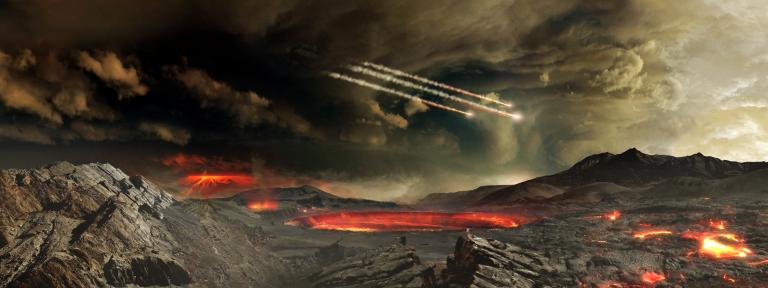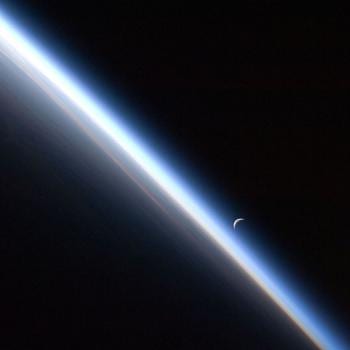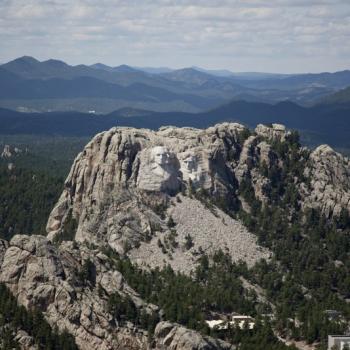
Current estimates of the age of the Earth put it at about 4.543 billion years.
That makes this find potentially stunning:
If the discovery isn’t overturned — has anybody seen anything to overturn it? — the biology on our planet is at least 3.77 billion years old, and it could even be as old as 4.28 billion years.
That means that organic life was underway on Earth within no more than 773 million years of Earth’s earliest existence — and perhaps within as little as 263 million years. In other words, it appeared just about as soon as it possibly could. And there’s no reason to believe that scientists have found the absolutely earliest organisms ever to have lived here. The odds are extraordinarily low that, by sheer dumb luck, out of all the geological materials that have been submerged beneath the seas or have been folded underneath tectonic plates or now happen to rest upon Earth’s surface — scientists happen to have found the very first living things.
But what, exactly, does it mean to say that the Earth is about 4.543 billion years old? Did it simply suddenly appear as a solid ball at that point, ready for the advent of giant Sequoias, lemurs, and Bernie Sanders?
Not even close.
Remember that, according to current scientific consensus, the Earth came into being in the same fashion that most if not all other objects in our solar system did, as a solidified cloud of dust particles and gases remaining as “left overs” from the same process that formed the Sun. Probably the remnants of an exploded supernova, or of more than one, these gases and particles coalesced into planets, asteroids, and comets because of mutual and ever increasing gravitational attraction. For maybe half a billion years, the interior of the planetesimal or protoplanet that would become Earth remained solid and (relatively) cool, perhaps at a balmy temperature of approximately 2,000°F.
I say “relatively cool” because, by contrast, when the Sun shrank in upon itself by a process of gravitational compaction it began the steady nuclear fusion that continues today, radiating heat and light and (ultimately) making our lives possible. But our future home would have been hot, even molten, because the solar system wasn’t yet the rather orderly place with distinct planets and clear orbits that it would eventually become. For a long time, large and ever growing planetesimals were colliding and merging with each other, and such collisions — creating friction on an inconceivably massive scale — generated enormous heat.
This is what is called the “Hadean” period of Earth’s history — running from roughly 4.6 billion to 4 billion years before the present. (The term Hadean comes, as you might have guessed, from the Greek noun Hades, which, in this case, signifies Hell. Not a bad description, as you will see.) In a sense, the Hadean period wasn’t really a geological period at all, because, with the exception of meteorites (which are, by definition, extraterrestrial), no rocks ever found on our planet are so old. In fact, some scientists use an altogether different term to refer to the earliest stages of Earth’s history, calling our protoplanet “Gaia” in order to distinguish from the solid planet that it eventually became.
The oldest meteoric rocks that have been discovered are currently dated — apart from the fascinating “Hypatia” stone, which deserves its own discussion — to between 4.5 and 4.6 billion years ago. The oldest lunar rock thus far dated has been placed at about 4.44 billion years of age. (Although the Moon is derivative of the Earth and thus offers some clues to our planet’s formation, it doesn’t experience plate tectonics and, with neither water nor an atmosphere, it doesn’t experience erosion, either. So ancient lunar rocks don’t disappear. Unless astronauts take them.)
But these conditions couldn’t (and didn’t) last forever. The main components of the Earth’s interior in that epoch, according to currently available evidence and theory, were iron and various silicates — that is, salts combining silicon and oxygen. But there were also small amounts of other elements, including some (notably uranium, thorium, and potassium) that were radioactive. It is the relative abundance of these heavier elements in the early Earth and in our solar system more generally that points to their origin in one or more supernovas, since such heavier elements, otherwise rather uncommon in the universe as a whole, are produced by stellar nuclear fusion. By mass, only about 2% of our galaxy is composed of “heavy elements” — that is, of elements other than hydrogen and helium. Those two “light elements” represent an astonishing 74% and 24%, respectively, of all of the baryonic matter in the universe. And baryonic matter, we should recall, represents only about 4.6% of the universe’s total energy, which is otherwise composed of dark energy (74%) and dark matter (24%).) (For a reflection on this subject from quite another angle, see my 2015 Deseret News column “Materialism isn’t what it used to be.”)
As millions of years passed, energy released from those elements by slow radioactive decay gradually heated the Earth, melting some of its constituent materials. The iron melted before the silicates could and, because it was heavier, it naturally sank toward the center. In turn, this forced the lighter silicates that its descent displaced to rise up toward the proto-planetary surface. After many years, that slowly sinking and coalescing iron reached the center of the still-forming planet — and attained stability — at almost 4,000 miles from the surface. Finally, enough iron accumulated at the Earth’s center to become our planet’s core, more or less as we know it today. Gravitation now kept it in place, because, obviously, to move further would be to move upward.
By contrast, the face of the Earth was still turbulent and unstable—suffering (as it were) gigantic earthquakes and even occasional sheer liquid bubbling, like simmering oatmeal. Erupting volcanos pocked the Earth, and flowing lava covered virtually all of it. Moreover, because the Earth’s protective atmosphere hadn’t yet come into existence, solar rays baked its outer surface and meteors frequently bombarded it. Hadean seems a pretty apt adjective to describe this period.
But the Earth inevitably began to cool, as everything in the universe is naturally fated to do, and a thin but (again) fairly stable crust of solid rock formed (as, again, sometimes happens with oatmeal). The oldest terrestrial rocks currently known to scientists date to roughly 3.8 billion years before the present. It’s probable that rocks existed on Earth prior to this, but hard evidence for them — pardon the pun! — may never actually be found, partly because most really old things aren’t found but mostly because any older rocks have likely been destroyed by erosion and the constant recycling of materials caused by plate tectonics and its perpetual subductions.
With the advent of solid terrestrial rock, perhaps somewhat prior to our oldest evidence from 3.8 billion years ago, the geological history of Earth properly began. This is what is called the “Archaean eon.”
Of course, the new, hard terrestrial crust wasn’t perfectly smooth. There were depressions (and elevations) in it. These formed natural basins. Meanwhile, water was rising from the interior of the planet through fissures and via volcanic eruptions, as well as being delivered by meteorites, and that water collected to form Earth’s primordial seas.
It was in these primeval oceans, most contemporary scientists believe, that the first stirrings of organic life occurred — and, as noted above, they seem to have occurred at least 3.77 billion years ago, and perhaps even as long ago as 4.28 billion years.
All of the processes summarized above — accurately, I hope — had to happen before the Earth was ready for biology to appear. And then life arose with incredible speed, almost (it now seems) instantly.
(The basic story that I tell above relies on the clear and helpful summary given in the article “Origin of Earth” on the “Infoplease” website.)












